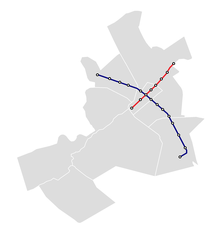 | ||
| Qom | ||
| Ostan (Province) | Qom | |
|---|---|---|
| Residents | 1.201.158 (2016) | |
| height | 928 m | |
| no tourist info on Wikidata: | ||
| location | ||
| ||
Qom is a provincial capital in Iran and an important pilgrimage destination as the “holy city” of the Shiite Muslims. The population has doubled since 1979.
background
The Qom River is one of two in Iran that carries water all year round. The Islamic universities have about 50,000 students.
getting there
By plane
Most foreign visitors are likely to be in Tehran arrive.
By train
Qom is on the Trans-Iranian railway line running north from Mashhad ↔ Tehran comes. From the south the route goes from the Persian Gulf at Khorramshahr or Māhshahr / Bander Eman Khomeini (Bandar Šâhpur) ↔ Ahvaz ↔ Arak until here.
By bus
In the street
The Tehran Expressway, the Persian Gulf Highway, is expanded to six lanes. It passes the city in the northeast.
mobility
Air pollution is high and traffic is chaotic.
metro


line A. The new 2019 metro connects the station with the shrine of Fatima Masuma to the Jamkarān mosque. After completion of the expansion, there will be as many stops over 14 kilometers. Part of the route will be built above ground for cost reasons.
The line M. is a monorail built on stilts, which initially also serves the shrine of Fatima Masuma for seven kilometers. It connects the main streets Ghods, Safashahr, Mahdieh and Shahid-e-Pardisan to the Khomeini Stadium.
Self-closing Japanese-type barriers will be set up at the entrances.
Tourist Attractions
,_Qom_-_24_September_2011_05.jpg/220px-Timcheh-ye-Bozorg_(Grand_Timcheh),_Qom_-_24_September_2011_05.jpg)
mosque
3 Hazrat Masoumeh Mosque (مسجد حضرت معصومه)
About 200 meters from the subway is still the 5 Gabriella Castle (قلعه گبری), accessible from 9 a.m. to 6 p.m.
Shrine of Fatima Masuma
Unbelievers are allowed to enter the courtyards, but officially not inside. However, there are guided, informative tours outside of prayer times. Cameras are not welcome, but discreet photography with the cell phone is tolerated.
The great forecourt Astane, is well attended in the early evening.
On the way from the sanctuary to the bazaar is the magnificently designed one 7 Martyrs' and military cemetery (گلزارشهدا باغ ملی قم), which is accessible from 6 a.m. to 6 p.m. This is also the direction of the 8 Imam Hassan Askari Mosque (مسجد امام حسن عسکری).
activities
1 Fairground (محل نمایشگاه های دائمی استان قم)
shop
If you are interested in minerals, you will find sulfur potassium salt crystals (aphthitalite), which are in the Salt dome, one of only forty sites around the world that want to be found.
- Bazaars
Connected by the main and commercial street Taleqani, which are a good 400 meters apart:
- 1 Historical / old bazaar (بازار کهنه). Worth seeing because of the winding architecture.Open: Sat.-Thu. 9.00-20.00.
- 2 Great bazaar (بازار بزرگ قم) (Metro Shahid Motahari شهید مطهری). Here, too, with impressively decorated domes.Open: 10.00-21.30.
kitchen
The local specialty is the sweet Son (سوهان), a calorie bomb made from sugar and pistachios, which are served as flat cakes.
accommodation
As a pilgrimage destination, Qom is well attended. Accommodation is occupied quickly, especially on relevant festivals or public holidays such as the Islamic New Year (August 19, 2021) and after Novruz (March 20/21), but also on Fridays.
- 1 Qom Hostel. Tel.: 98 938 735 0826.
Upscale
- 2 Qom International Hotel (هتل بین المللی قم) (directly at the shrine of Fatima Masuma, on the side of the Märyrerfriedhof). 79 rooms, the "first house on the square."Price: around € 50.
security
If the political situation, which has been very tense since November 2018, worsens further, American or Israeli air or rocket strikes against the Iranian nuclear program facilities located on the outskirts and the test site for missiles can be expected. Damage to life and limb of civilians cannot be avoided here.
climate
Qom is over 900 meters high. Night frosts occur in December and January. Winter is also the time of (little) rainfall, so snow is not unknown. Daily maximum temperatures well above 40 ° C are common from May to September. The most bearable travel times are March to mid-May and October to November.
health
Practical advice
As a religious center, dominated by a conservative clerical caste, "appropriate" clothing is to be worn according to the Islamic understanding, i.e. no short sleeves or trousers for men.
trips

Kavir National Park
The 4000 square kilometer nature reserve of the 10 Kavir National Park is on the western edge of the Kawir Desert, about one hundred kilometers from Qom. Wild goats, wild sheep, striped hyenas, wolves and gazelles as well as the rare Asian cheetahs and the Persian leopard live in the desert and steppe landscape of the park. The vegetation of the desert consists mainly of succulents. Overgrazing by the local nomads and an oil project endanger the stocks of this UNESCO biosphere reserve.
The banks of the 11 Namaksees (Daryācheh-ye Namak دریاچه نمک). It is more of a "salt marsh" in which there is more or less liquid depending on the water level of the Qom River.
- getting there
From Qom or Kashan.
There are special tourist trains that operate as a day tour from Tehran "Crossing Alborz" also drive through the Kawir desert.
literature
See also the general travel guide for Iran.
- Drechsler, Andreas; History of the city of Qom in the Middle Ages: (650-1350); political and economic aspects; Berlin 1999 (black); ISBN 3879972761
- Sadeghi, Zohreh; Fāṭima of Qum: an example of the worship of holy women in the popular belief of the Twelve Shia; Berlin 1996 (black); ISBN 3879972559
- Tourist map of Qom city; Tehran 2014 (Gitashenasi); 1: 15000, 67 x 97 cm, folded; ISBN 9789643424404
Web links
- Route network and planning status of the metro (only Farsi)




